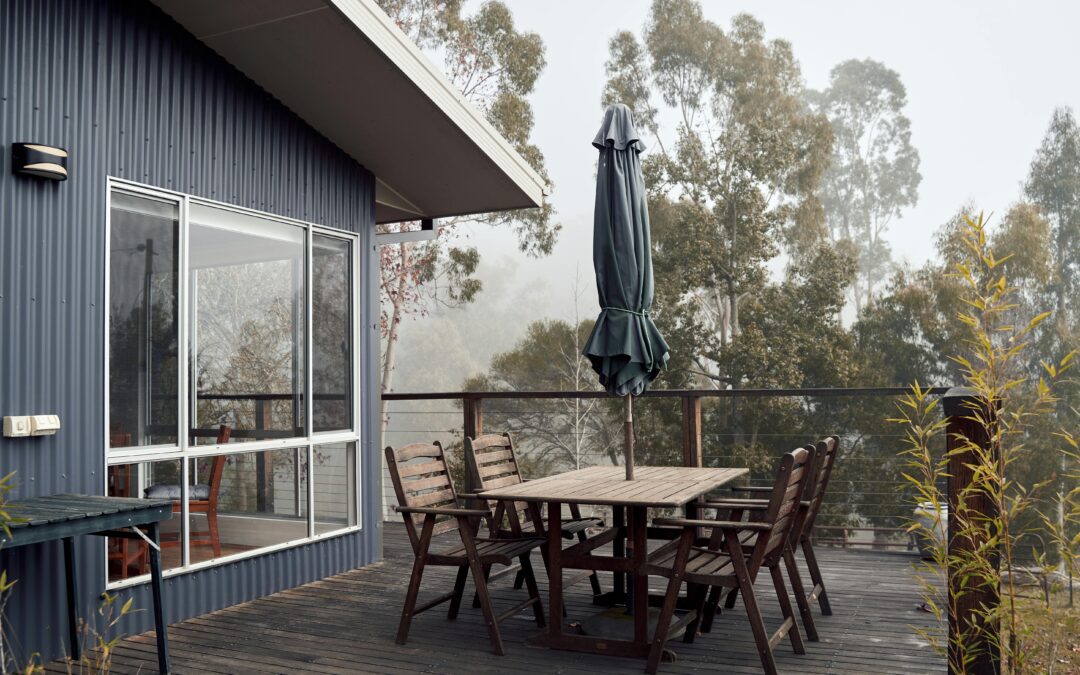Introduction
A great deck isn’t complete without a solid railing, but railings do more than meet safety codes. The right railing can transform the look of your outdoor space, adding personality, curb appeal, and function all at once.
Whether you’re building a new deck or upgrading an old one, here’s a breakdown of popular deck railing options that strike the right balance between safety and style.
1. Classic Wood Railings
Wood railings are a natural match for wood decks and remain a go-to choice for homeowners who like a traditional, warm look.
Pros:
- Can be built to match your deck exactly
- Easily painted or stained
- Affordable material cost
Things to consider:
Wood railings require regular upkeep, staining, sealing, and occasional replacement of weathered parts. But for those who enjoy a classic style and don’t mind some maintenance, it’s a great choice.
2. Aluminum Railings
Aluminum railings are gaining popularity thanks to their clean lines, minimal upkeep, and long lifespan.
Pros:
- Rust-resistant and durable
- Low maintenance
- Available in several colours and styles
- Sleek, modern appearance
Things to consider:
They cost more up front than wood but make up for it with minimal upkeep. A good option for homeowners who want a clean, contemporary look without future painting or staining.
We often recommend aluminum to Lower Mainland clients looking for long-term value in a damp climate.
3. Glass Panel Railings
Want to keep the view open while still maintaining safety? Glass railings offer a clear sightline, especially useful if your deck overlooks a garden, forest, or water.
Pros:
- Unobstructed view
- Modern and high-end look
- Wind protection without blocking light
Things to consider:
Glass railings require regular cleaning, especially in areas exposed to rain or pollen. They also tend to be one of the pricier options, but many homeowners find the finished result is worth the investment.
Tip: Frosted or tinted panels can offer privacy without fully closing off the space.
4. Cable Railings
Cable railing systems use horizontal stainless-steel cables in place of traditional pickets. They’re commonly used in modern designs and are especially popular on decks with scenic views.
Pros:
- Minimal visual obstruction
- Strong and safe
- Low maintenance with proper installation
Things to consider:
Cable tension needs occasional adjustment, and installation should be done carefully to meet code and avoid sagging. They pair well with wood, aluminum, or composite posts.
We’ve installed cable railings on several high-end decks across the Lower Mainland, they’re a solid choice when you want a clean look that doesn’t distract from your surroundings.
5. Composite Railings
Composite railings are made from the same material as composite decking, often a blend of wood fibers and plastic. They offer a consistent look and require less upkeep than wood.
Pros:
- Long-lasting and weather-resistant
- No painting or staining required
- Matches composite decking for a clean finish
Things to consider:
Composite is heavier and more expensive than wood or aluminum. It’s best used on decks that already use composite boards to keep everything visually aligned.
6. Custom Combos
Sometimes, the best option is a mix. You might pair a cedar top rail with black aluminum pickets. Or combine glass panels with a wood frame. These hybrid designs let you keep costs manageable while still adding unique visual appeal.
Benefits of mixing materials:
- Keeps the look balanced
- Offers flexibility for budget and design
- Allows you to highlight key views or areas
If you’re not sure how to combine elements, All Hands on Deck can help you design something that fits your home and yard perfectly.
Choosing Based on Function
When picking a railing system, ask yourself:
- Who will use the deck? Kids and seniors may benefit from more enclosed or easy-to-grip styles.
- Do you need privacy or openness? Glass and cable keep things airy. Wood and composite feel more solid.
- How much time do you want to spend on maintenance? Aluminum and composite are the lowest-maintenance. Wood needs the most upkeep.
- What’s your budget? Wood is the most cost-effective. Glass and custom designs cost more but can add serious style points.
Safety First
Every railing we install meets or exceeds B.C. building code standards. That means proper height, spacing between pickets, and secure fastening. Whether you’re 2 feet off the ground or 10, safety isn’t negotiable, and we don’t cut corners.
See What’s Possible
Want to explore your options before making a decision? Check out our project gallery to see how different railings look in real homes. We’re happy to walk you through choices during your consultation and help match the right style to your space.
Let’s Build a Deck That Looks, and Feels, Right
At All Hands on Deck, we take railings as seriously as we take framing and layout. We’ve worked with every material and can guide you to a setup that’s safe, smart, and good-looking.
Need help picking the right railing for your new or existing deck? Contact us to request a quote or design consult today.



Recent Comments